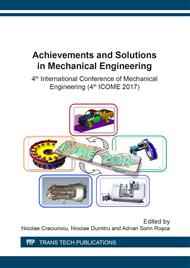[1]
Anthony Papillon, Jean-Michel Missiaen, Jean-Marc Chaix, Sophie Roure, Hans Schellekens, Sintering mechanisms of Cu-Cr metallic composites, Int. Journal of Refractory Metals and Hard Materials 65 (2017), p.9–13.
DOI: 10.1016/j.ijrmhm.2016.11.010
Google Scholar
[2]
Wataru Kimura, Yuji Kume, Makoto Kobashi, Naoyuki Kanetake, Consolidation of Cr-Cu/Cu powder laminated material by compressive torsion processing, Procedia Engineering 81 (2014), p.1169 – 1174.
DOI: 10.1016/j.proeng.2014.10.283
Google Scholar
[3]
R. Raj, R.K. Bordia, Sintering behaviour of bimodal compacts, Acta Metall. 32 (1984), p.1003–1019.
DOI: 10.1016/0001-6160(84)90003-8
Google Scholar
[4]
A. Jagota, G.W. Scherer, Viscosities and sintering rates of composite packings of spheres, J. Amer. Ceram. Soc. 78 (1995), p.521–528.
DOI: 10.1111/j.1151-2916.1995.tb08209.x
Google Scholar
[5]
O. Sudre, G. Bao, B. Fan, F.F. Lange, A.G. Evans, Effect of inclusions on densification. II. Numerical model, J. Amer. Ceram. Soc. 75 (1992), p.525–531.
DOI: 10.1111/j.1151-2916.1992.tb07837.x
Google Scholar
[6]
D. Bouvard, F. Lange, Relation between percolation and particle coordination in binary powder mixtures, Acta Metall. Mater. 39 (1991), p.3083–3090.
DOI: 10.1016/0956-7151(91)90041-x
Google Scholar
[7]
D. Bouvard, Densification behaviour of mixtures of hard and soft powders under pressure, Powder Technol. 111 (2000), p.231–239.
DOI: 10.1016/s0032-5910(99)00293-4
Google Scholar
[8]
C. Suryanarayana, Mechanical Alloying and Milling, Marcel Dekker, New York, (2004).
Google Scholar
[9]
C.C. Koch, Synthesis of nanostructured materials by mechanical milling: problems and opportunities, Nanostructured Mater. 9 (1997), pp.13-22.
DOI: 10.1016/s0965-9773(97)00014-7
Google Scholar
[10]
Z.M. Zhou, Y.P. Wang, J. Gao, M. Kolbe, Microstructure of rapidly solidified Cu-25 wt. % Cr alloys, Mater. Sci. Eng., A 398 (2005), p.318–322.
DOI: 10.1016/j.msea.2005.03.095
Google Scholar
[11]
K.M. Youssef, R.O. Scattergood, K. Linga Murty, C.C. Koch, Ultratough nanocrystalline copper with a narrow grain size distribution, Appl. Phys. Lett. 85, (2004), pp.929-931.
DOI: 10.1063/1.1779342
Google Scholar
[12]
M.A. Atwater, D. Roy, K.A. Darling, B.G. Butler, R.O. Scattergood, C.C. Koch, The thermal stability of nanocrystalline copper cryogenically milled with tungsten, Mater. Sci. Eng. A 558 (2012), pp.226-233.
DOI: 10.1016/j.msea.2012.07.117
Google Scholar
[13]
Benjamin J.S., Dispersion strengthened superalloys by mechanical alloying, Met Trans, (1970), pp.1-43.
Google Scholar
[14]
Maurice D.R., C. T., Modeling of mechanical alloying Part III, Application of computational programs, Metall. Mater. Trans. A, (1995), pp.2437-2444.
Google Scholar


